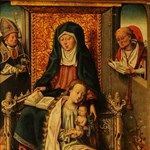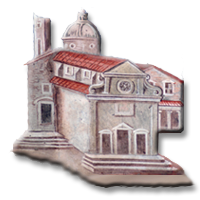Introduzione
Saint Anne, the mother of the Virgin Mary, appears on a throne of Wisdom. Her daughter, the Virgin Mary, sits before her and cradles the naked Christ Child. He holds a goldfinch, a symbol of his Passion. Two saints regard the scene. The painting is now thought to be by the workshop of the Master of the Saint Bartholomew Altar, named after panels from an altarpiece now in the Alte Pinakothek, Munich.
fonte: http://collection.waddesdon.org.uk/
The Bartholomew Master appears to have come from Utrecht, but trained in Cologne, Germany as a painter and manuscript illuminator. From around 1480, he ran a workshop in Cologne employing other painters to help him produce religious panel paintings and portraits for patrons in Cologne and the Netherlands particularly Gelderland, Arnhem and Utrecht. He was influenced by art from both these regions, including prints and sculpture. This painting originally came from Hilversum, near Utrecht. The composition has similarities with polychrome sculpture from both South and North Netherlands.
Although the work is similar to others attributed to the Master, there are certain characteristics that suggest the work is by his workshop rather than by the Master. There are weaknesses such as stiffness of the figures; the schematic representation of the drapery; the inconsistencies in the spatial organisation of the scene; and the incorrect lettering in the drapery of Anne. The composition of the painting, the grass and flowers in the foreground, the position of the Christ Child, and Anne's face, are similar to details in the 'The Virgin and Child with Musical Angels', National Gallery, London (NG 6499), also attributed to the Master's workshop.
The central figures and throne are based on an earlier engraving of around 1480 by the Master M with the Key showing the genealogy of the Virgin (Berlin, Staatliche Museen Preßuischer Kulturbesitz, Kupferstichkabinett, Inv. nr. 210-1886). The not unusual practice of using the engraving as a pattern suggests it is also by the workshop rather than the Master. In the painting, Anne sits on a seat of Wisdom which also represents Solomon's great throne of ivory and gold with lions on the arms (1 Kings, 10. 18:20). This detail was based on the engraving where the throne represents the ancestors of Christ.
The two figures viewing the scene, Saints Augustine and Jerome, are Doctors of the Catholic Church, recognised for their important scholarship and writings about the Catholic faith. Saint Augustine, on the left, is shown holding out his wounded heart to Christ, with the monogram of Christ inscribed on the wound. This form of depicting the Saint, which does not appear before the 15th century, is due to a sentence in Saint Augustine's 'Confessions' (M.XXXII. 764) 'Sagittaveras tu cor nostrum charitae tua et gestabamus verba tua trandfixa visceribus' (Thou hast pierced our hearts with Thy charity and we have carride Thy words scored on our vitals).
Phillippa Plock, 2012



